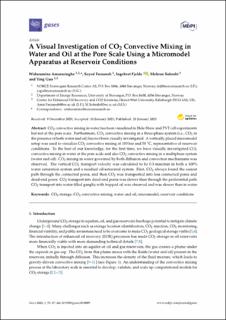| dc.contributor.author | Amarasinghe, Widuramina Sameendranath | |
| dc.contributor.author | Farzaneh, Seyed | |
| dc.contributor.author | Fjelde, Ingebret | |
| dc.contributor.author | Sohrabi, M | |
| dc.contributor.author | Guo, Ying | |
| dc.date.accessioned | 2021-12-13T15:18:19Z | |
| dc.date.available | 2021-12-13T15:18:19Z | |
| dc.date.created | 2021-08-12T13:36:30Z | |
| dc.date.issued | 2021-01 | |
| dc.identifier.citation | Amarasinghe, W., Farzaneh, S., Fjelde, I., Sohrabi, M., & Guo, Y. (2021) A Visual Investigation of CO2 Convective Mixing in Water and Oil at the Pore Scale Using a Micromodel Apparatus at Reservoir Conditions. Gases, 1(1), 53–67. | en_US |
| dc.identifier.issn | 2673-5628 | |
| dc.identifier.uri | https://hdl.handle.net/11250/2834046 | |
| dc.description.abstract | CO2 convective mixing in water has been visualized in Hele-Shaw and PVT cell experiments but not at the pore scale. Furthermore, CO2 convective mixing in a three-phase system (i.e., CO2 in the presence of both water and oil) has not been visually investigated. A vertically placed micromodel setup was used to visualize CO2 convective mixing at 100 bar and 50 °C, representative of reservoir conditions. To the best of our knowledge, for the first time, we have visually investigated CO2 convective mixing in water at the pore scale and also CO2 convective mixing in a multiphase system (water and oil). CO2 mixing in water governed by both diffusion and convection mechanisms was observed. The vertical CO2 transport velocity was calculated to be 0.3 mm/min in both a 100% water saturation system and a residual oil-saturated system. First, CO2 always found the easiest path through the connected pores, and then CO2 was transported into less connected pores and dead-end pores. CO2 transport into dead-end pores was slower than through the preferential path. CO2 transport into water-filled ganglia with trapped oil was observed and was slower than in water. | en_US |
| dc.language.iso | eng | en_US |
| dc.publisher | MDPI | en_US |
| dc.relation.uri | https://doi.org/10.3390/gases1010005 | |
| dc.rights | Navngivelse 4.0 Internasjonal | * |
| dc.rights.uri | http://creativecommons.org/licenses/by/4.0/deed.no | * |
| dc.subject | karbonlagring | en_US |
| dc.subject | olje og vann | en_US |
| dc.title | A Visual Investigation of CO2 Convective Mixing in Water and Oil at the Pore Scale Using a Micromodel Apparatus at Reservoir Conditions | en_US |
| dc.type | Peer reviewed | en_US |
| dc.type | Journal article | en_US |
| dc.description.version | publishedVersion | en_US |
| dc.rights.holder | © 2021 by the authors | en_US |
| dc.subject.nsi | VDP::Teknologi: 500::Berg‑ og petroleumsfag: 510::Petroleumsteknologi: 512 | en_US |
| dc.source.pagenumber | 53-67 | en_US |
| dc.source.volume | 1 | en_US |
| dc.source.journal | Gases | en_US |
| dc.source.issue | 1 | en_US |
| dc.identifier.doi | 10.3390/gases1010005 | |
| dc.identifier.cristin | 1925609 | |
| dc.relation.project | Norges forskningsråd: 268439 | en_US |
| cristin.ispublished | true | |
| cristin.fulltext | original | |
| cristin.qualitycode | 1 | |

